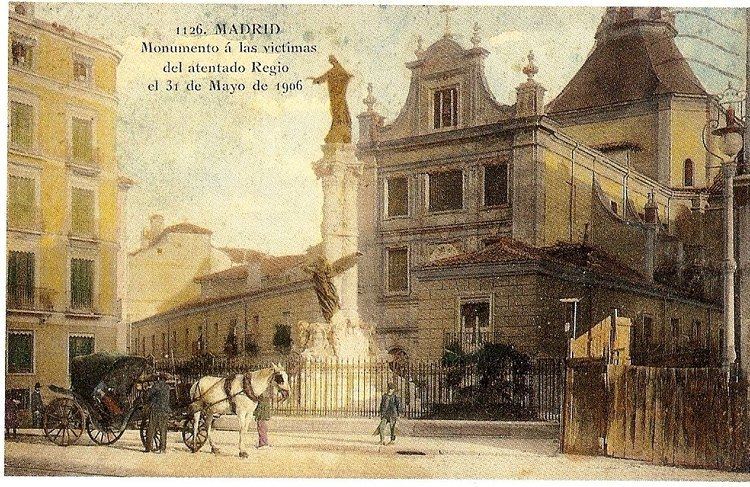 | ||
Similar Palacio del Marqués de Casa, Convento de San Norberto, Palacio del Duque de Uceda, Palacio de Xifré, Iglesia del Buen Suceso | ||
The monument to victims of the attack against Alfonso XIII, is a monument in Madrid, Spain, as well as a former monument that it replaced.
Contents
The current, smaller monument stands in the square formed by the confluence of the calles Mayor, del Sacramento and Pretil de los Consejos, near the Church of the Sacrament and the Palacio de los Consejos.
It was built in 1963, replacing an earlier sculpture, far greater than the current one, that was constructed in 1908 and dismantled by the Second Republic (1931–1939). It is located opposite the place where an attempt was made against the life of King Alfonso XIII on 31 May 1906, the day on which he married Victoria Eugenie of Battenberg.
The attack
The assassination attempt occurred during the wedding parade held at the end of the religious ceremony of the Hieronymites, as the king was returning to the Royal Palace in the middle of a large crowd. The delegation was composed of 19 royal carriages and 22 corresponding to the grandees of Spain.
The Catalan anarchist Mateu Morral, inspired by the anarchist movement in Spain, threw a homemade bomb, disguised in a bouquet of flowers, from the top floor of the building at Calle Mayor number 84, where the popular tavern Casa Ciriaco is located. The bomb was directed against the carriage carrying the royal couple but bounced off and ended up exploding into the crowd.
The king and queen were uninjured, but almost thirty were killed and a hundred wounded, in what is the second bloodiest attack in the history of the city, after the 2004 Madrid train bombings.
First monument
The first monument was designed by the architect Enrique Repullés y Vargas and executed by the sculptor Aniceto Marinas. It was completed in 1908, from an initiative of the Duchess of la Conquista.
At its summit was a sculpture of the Virgin of Beautiful Love, referring to the day the attack occurred, on which is celebrated this Catholic feast day. The sculpture was atop a large pedestal consisting of three columns, symbolizing the people, the army and the aristocracy. Several groups of floral wreaths climbed the columns to the feet of the Virgin.
At its base, the monument was widened to accommodate several tombstones, on which were inscribed the names of the deceased. The figure of an angel guarded the pedestal.
After its dismantling by the Second Republic, the remains of this work were spread across various places in the city. Some of its elements, including the aforementioned tombstones, were used to erect another monument, intended for the regimental headquarters of Wad Ras, and others were stored in municipal warehouses.
Parts of the pedestal are now preserved in the Parque de Olof Palme, in the District of Usera.
Current monument
On 13 July 1949 the Madrid municipal government held a competition for the design of a new monument in memory of the attack. The winning design, by Santiago Otalba Hernández, was a sculptural group comprising images of the Immaculate Conception and two angels holding the royal arms, along with a cross of dark granite with bronze embellishments. However, the project failed to materialize, with the resignation of the artist.
It took more than a decade to achieve the current monument, designed by Madrilenian sculptor Federico Coullaut-Valera and completed in 1963. It was not until 1970 that there was added a marble plaque with the commemorative legend "In memory of the victims of the attack against Their Majesties Don Alfonso XIII and Doña Victoria Eugenie on 31 May 1906".
The monument consists of a bronze sculpture of a semi-kneeling angel, holding a scroll in his hands, on a granite pedestal, behind which rises a simple stone monolith that surpasses him in height. It measures 2.6 metres (8.5 ft) high and 1.5 metres (4.9 ft) wide and is made of limestone veneer. On its main face, behind the angel, is a bronze plaque, on which there appears in relief a shield of Madrid stamped with the royal crown, surrounded by herbal decoration.
